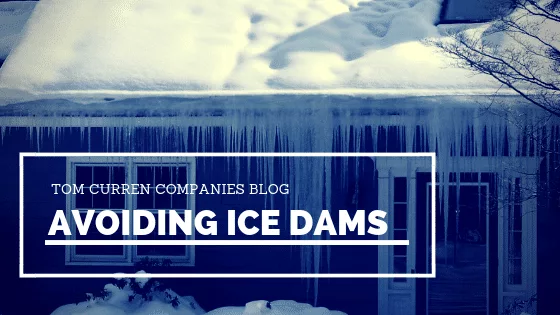Avoiding Ice Dam Damage

Massachusetts homeowners deal with the large amount of snow and temperatures flip-flopping above and below freezing, so it’s good to keep an eye out for ice dams that may build up on roofs.
Accumulated snow that doesn’t have the chance to melt before the next snowfall hits, or that starts to melt but freezes again before it’s fully melted off, can create a backlog of frozen precipitation and build up on the roof of your home, potentially causing some serious damage – like ice dams.
Generally speaking, the radiant heat from the sun on a bright day will be enough to melt the snow on your roof, allowing it to flow into the gutters and out through the downspouts. On roofs without gutters, the snow simply drips off the edge onto the ground. Regardless of the mechanism, as long as water has a route to flow off the roof, everything is fine. However, if a heavy build of snow has accumulated on the roof, and is only partially melting, chances are that the water can’t escape the roof, and that’s where the big problems begin.
What Happens:

Snow on a roof doesn’t all melt at the same rate and in many cases, the main body of a rooftop gets warmer than the outer edges. When the roof is warm in the middle and still cold on the edges, the water that is trying to escape the roof gets blocked – or dammed – by the snow and ice that hasn’t melted around the edges. The water retained on the surface of the roof can actually form a small “pond” behind the ice dam, and this water can seep into cracks on the roof and underneath the shingles. This can create leaks, mildew, water damage and can affect the integrity of your roof.
How do you know if there is an ice dam problem?
The most prominent sign that ice dams are present are large icicles hanging from the gutters and roof edges. You may notice brownish, tea-colored stains on the first and second story ceilings around the perimeter of your home, or water in the basement. The best thing to do is make sure to take a look around the inside and outside of the house and see if there are any visible indicators.
What to do if you notice an ice dam:
Fixing most ice dam-related issues in the home is relatively simple. Gutters may need to be cleaned, or attic vents cleared. More persistent problems might require an upgrade in attic ventilation or the installation of heater cables. If you think you may have an ice dam problem give Tom Curren Companies a call or request a quote online and we’ll come by and take a look and recommend realistic solutions.
We are the official Gutter Cap® & Heater Cap® dealer for Massachusetts, and we’re trained in how to install solutions to ice dam problems. Prevention is critical so remember to tackle the little problems before they become big problems. If you think there are issues, don’t hesitate to give us a call. We’re here to help, and if we can’t fix it ourselves, chances are we know someone trustworthy and reliable who can.

CHECK OUT
Related Projects
READ OUR
Related Ideas
Locations












